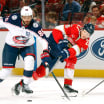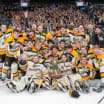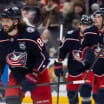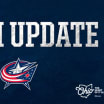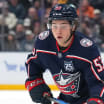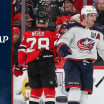They came from near and far. Some were has-beens and never-weres. Others were NHL stars trying to recapture their games. Many were youngsters trying to prove they had what it takes to play in the best league in the world.
Two decades later, their names roll off the tongue for many Blue Jackets fans. Geoff Sanderson, Espen Knutsen, Kevin Dineen, Tyler Wright, David Vyborny, Jean-Luc Grand-Pierre and Ron Tugnutt, to name just a few, remain fan favorites all these years later.
But from Steve Heinze to Steve Maltais, Jamie Heward to Jamie Pushor, Mattias Timander to Mathieu Darche to Matt Davidson, there's plenty of memorable men who suited up on the first-ever Blue Jackets team 20 years ago.
First Blue Jackets team still endures 20 years later
Two decades after the inaugural season, the memories live on for the Blue Jackets and the fan base
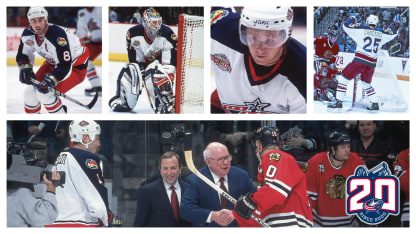
By
Jeff Svoboda
BlueJackets.com
One year ago tomorrow, their inaugural run came to a close, and it did so on a high note. On April 8, 2001, Wright's overtime goal to clinch a 4-3 win over Chicago delighted a full house in Nationwide Arena, concluding the first Blue Jackets season with a bang.
Tyler Wright ends the first CBJ season with a bang
The record read just 28-39-9-6, good enough to tie the Blackhawks for last place in the Central Division, but there were plenty of high points on the ice that first season.
Perhaps even more notable, a group of players with varied backgrounds, who might not have been able to find Columbus on the map a year prior, came together for one heck of a fun season. For many, as they look back, it was one of the best years of their hockey lives, battling for one another and a city while coming together to play in front of a rabid, excited new fan base.
"The biggest thing that stuck with me is how close the group was," said Grand-Pierre, who remains in Columbus and is now an analyst on the team's Bally Sports Ohio broadcasts. "It's funny because the expansion draft at that time was mostly a bunch of outcasts. We had a few established NHL players, and then a lot of young guys that were looking to put their foot in the NHL and stick.
"Whether it was veterans like Lyle Odelein or Bruce Gardiner or a young guy coming up like me and Marc Denis, we were all in the same boat. The guys that got let go like Lyle wanted to show that they still had something in the tank, and the young guys wanted to prove something.
"We had this common bond. Obviously the excitement of a new franchise is always nice, but as far as the teams I've been around, that had as much fun as I've ever had yet played as hard as they could, that was probably the one group that would stick in my head."
Building the Jackets
Unlike a couple of years ago, when an expansion team in Vegas made it to the Stanley Cup Final, teams were not set up for quick success by when the Blue Jackets came into existence.
Two seasons prior to the start of the Jackets' franchise, an expansion team in Nashville won 28 of 82 games its first season. In 1999-2000, Atlanta came into the league and won just 14 games. Go back to 1992-93, when Ottawa came into the league, the Senators won just 10 games their first season and 14 a year later.
In other words, teams knew it was going to be a tough road to glory, and it was even tougher for the Blue Jackets as Minnesota came into the league the same year.
With two brand-new teams looking for players to stock their rosters, the league allowed existing teams to protect either one goaltender, five defensemen and nine forwards (15 players overall) or two goaltenders, three defensemen, and seven forwards (12 players overall) in the expansion draft. For comparison's sake, when Vegas entered in 2016-17, the setup allowed teams to protect 11 players (a goalie, three defensemen and seven forwards) or nine (one goalie, eight skaters of any position).
"It was really interesting because Nashville had come in and Atlanta had come in and had really taken a good chunk of the pool, then Minnesota and us both came in at the same time," then-CBJ general manager Doug MacLean
told Jody Shelley earlier this year
. "The rules were really tough. I remember talking to Doug Risebrough, the GM in Minnesota, we couldn't really cut deals with teams the way Vegas and Seattle have been able to because of the fact we were both picking.
"We had to cut deals between ourselves, and that wasn't going to happen. It was a real trying thing."
The draft was also held position-by-position, with goaltenders going first followed by defensemen and then forwards. Of course, there were plenty of side deals and other things going on -- for example, before the draft, Columbus had already sent a second-round draft pick to Colorado for goalie prospect Denis, but the deal was contingent on the CBJ selecting goalie Rick Tabaracci so as not to take young netminder David Aebishcer or anyone else from a contending Avs team.
Relive our inaugural game!
Meanwhile, many of the top names left unprotected were either high-priced, fading stars on big contracts -- something that wasn't attractive to two teams looking to build for down-the-road success -- while both the Blue Jackets and Wild also saw the opportunity to select players on expiring contracts who would then be free agents, with the teams not on the hook for any money or the players.
In all, it led to a setup for an expansion draft that was as much about strategy as building a team.
"The frustrating thing was with that expansion draft … I had traded for Denis with Colorado and had cut a deal with Tugnutt to come in as our goaltender," MacLean told Shelley. "So I had to waste picks, picking goalies. I picked Tabaracci and I picked a couple of other goaltenders because I already had my goalies, but I couldn't tell anybody I had my goalies. But so many of our picks and Minnesota's picks were wasted picks because teams just exposed their high-priced guys, so we ended up wasting a ton of picks.
"I remember Bill Daly (with the NHL) calling Risebrough and I down to the hotel lobby in the middle of the draft saying, 'OK boys, enough of these games. You're wasting picks.' We said, 'Yeah, we're not taking a $4 million player when our payroll is gonna be $17 million.' It was a challenging, fun experience, but something you'll never forget, you know?"
In the end, just 11 players of the 26 drafted by Columbus would play for the team, but it did put a core in place. Such names as Sanderson, Heinze, Dineen, Gardiner, Odelein, Pushor, Timander, Kevyn Adams and Robert Kron were taken in that draft, while Columbus already had acquired Denis, Chris Nielsen and Espen Knutsen in trades, claimed Heward off waivers and signed Vyborny.
Grand-Pierre and Deron Quint would come in trades as well over the weekend, while Rostislav Klesla was the team's first-ever amateur draft pick a day later. Tugnutt, Serge Aubin, Frantisek Kucera, Mike Maneluk and Petteri Nummelin, all key parts of the first team, were signed in free agency before the start of the season, and suddenly you had a team.
And to hear Tugnutt tell it, it very quickly became a team.
"You know something? The hockey world is a small world, and hockey players are all the same," the veteran goalie said. "So to walk into a dressing room and have 22 or 23 new teammates that for the most part I hadn't played with, to have to meet these new guys, it sounds funny but it took maybe an hour for all of us to start liking each other. Because you have everything in common, right?
"You're on the same team. You're like, 'This is great! We're playing here in Columbus', and I remember laughing with some guys where they were saying things like, 'I had to go to a map to find out where Columbus, Ohio, was.' And I laughed and I said, 'How warm does it get there in the winter? What is the temperature?' We were all trying to figure things like this out before getting there."
A Bonding Experience
As Tugnutt said, the city of Columbus was a bit of mystery to the NHLers who showed up. After a number of iterations of IHL teams in the 1960s and '70s, hockey in the city was largely dormant through the '80s until the Columbus Chill of the ECHL arrived in 1991. It took off immediately, with a viral marketing campaign and the wild nature of minor league hockey making the team an instant sensation.
But that was two levels below the NHL, and high-level veterans like Sanderson and Odelein weren't exactly coming through the city in the Chill days. Finding Columbus, Ohio, on a map, as compared to say Columbus, Ga., was new to many of those players, but they quickly found a fan base excited for its shot at the big leagues.
Ohio had plenty of experience with major league sports in Cleveland and Cincinnati, plus Columbus was known for Ohio State football and basketball at the time. When the players arrived, they found a quickly growing city ready to embrace its first-ever entrant into one of the four major pro sports.
Ron Tugnutt makes history with first shutout.
"I can probably speak for everyone on the team that year, it was a great opportunity, that's what it was," Sanderson
told Shelley in an interview last year
. "The NHL created 22 new jobs, and we were all fringe players on our other teams we were on, so it was a great opportunity.
"Just coming into Columbus that summer, you could just tell the excitement. People were excited to see the new arena in downtown Columbus. It's such a big sports state with the football and basketball programs. Hockey just fit in there perfect."
But when the squad got together in the fall of 2000 to get ready for the first season of CBJ hockey, it didn't take long for a couple of things to become clear.
First, everyone had something to prove, and second, that energy provided by a fan base excited for an NHL team was palpable.
When it came to training camp, that led to a bit of an issue.
"I'll never forget our very first training camp at the Ice Haus," Grand-Pierre said. "A typical training camp is guys playing hard, you're trying to get a spot, and Doug MacLean had to finally come down and say, 'Guys, stop the fighting. This is ridiculous.' The fans were getting excited at any hit, any shot. You'd hit the glass with a slap shot and they would be clapping.
"They would get excited for anything that was happening, and the next thing you know guys are starting to fight and it became stupid because we're all on the same team, but yet everybody was fighting. It was the adrenaline you are getting from thousands of fans watching an irrelevant practice in training camp. It was so great, and throughout the season we felt that behind us as well."
By the end of camp, the team roster was set for the Oct., 7, 2000, opener. The forwards were Adams, Aubin, Jan Caloun, Dineen, Gardiner, Heinze, Kron, Maltais, Krzysztof Oliwa, Sanderson, Vyborny and Wright, with captain Odelein leading a defense that also featured Klesla, Kucera, Nummelin, Pushor and Timander, while Tugnutt was in net for the opener.
And to say it was a dream start was an understatement. In front of a roaring crowd in Nationwide Arena, Gardiner crashed the net and scored the first goal in franchise history 7:34 into the opener, then Vyborny and Heinze followed with goals in the next 1:46. The roof nearly came off of brand-new Nationwide Arena as less than 10 minutes into the first game in franchise history, the Jackets held a 3-0 lead.
What came next was perhaps a sign of what was to come, though, as Columbus gave up three goals to the Blackhawks in a six-minute span of the second to tie the score. Swiss forward Reto Von Arx would score just three goals in his NHL career, but his second tally of the game at 2:32 of the third would go down as the game winner, as Chicago rallied to take a 5-3 win.
"I remember game one, I'm thinking, 'Oh my God, this is the most exciting (thing),'" MacLean said. "My parents flew in from (Prince Edward Island). We were all there as a family, I hosted a bunch of people from PEI for that first game, and we go up in the first period 3-0. I was going, 'This is easy,' and we lose the game and I'm like, 'Oh man, here we go.' "
A Fantastic Finish
As was predicted, it was a struggle for the Blue Jackets early. With the new players taking time to learn each other's games and jell together, it was a rough start, as after falling to Chicago, the Blue Jackets were blown out in game two at home, dropping a 7-1 final against the Los Angeles Kings.
Columbus won its first-ever game in its third try, winning in Calgary on Oct. 12 by a 3-2 score, but six straight losses followed to drop the team to 1-7-0-1. The Blue Jackets captured their first-ever home game on Oct. 27, downing Washington by a 3-1 score, but the typical struggles of an expansion team took over from there. For example, Columbus won four in a row from Nov. 9-16, then scored just nine goals in the next eight games, losing them all to fall to 7-18-1-1.
Top 20 Moments for Feb. 8, 2021.
But a funny thing happened as the season went on. The chemistry slowly built and built throughout the season, and a Feb. 25 win in Anaheim kick-started a strong finish to the campaign. That triumph started a run of three wins in a row and six victories in eight games, and by the time Wright finished off the season with that overtime goal against Chicago, the Blue Jackets were 10-8-2 in their last 20 games.
"We did all the little things that make a difference, and there were no exceptions to the rule," King said. "The Jamie Pushors, the Lyle Odeleins really pushed everybody to buy in and do all those things. I wrote a book called Loose Pucks and Ice Bags, and It really reflected the season with the Blue Jackets in so many ways because we had to get to loose pucks because it made a big difference. We had to block a lot of shots and take a lot of hits, so ice bags were appropriate."
When it was all said and done, the Blue Jackets didn't make the playoffs, but no one really expected they would. But there was one victory that meant a lot to both King and MacLean -- with 71 points, Columbus finished three ahead of fellow expansion team Minnesota, which the franchise's leaders had established as one of the primary goals going into the campaign.
"They were our benchmark all year," King said.
"It was almost like winning the Stanley Cup, to be quite honest," MacLean said. "It was so exciting that we finished ahead of Minnesota."
When the dust settled, Sanderson led the way with 30 goals -- including the team's first-ever hat trick -- as well as 56 points. Knutsen was a revelation, as the 29-year-old Norwegian forward known as "Shampoo" led the team with 42 assists among his 53 points in his first full NHL season.
Heinze added 22 goals and 42 points, while Wright (16 goals), Vyborny (13), Aubin (13) and Heward (11) all reached double digits in goals. Odelein, Timander and Quint led the team in minutes from the blue line, while Tugnutt won 22 games to set a record for a goalie on an expansion team.
"You look at Geoff Sanderson, he was a heck of an NHL player and he was our gifted top offensive guy and scored so many important goals for us," King said. "Lyle Odelein was our captain and he was a grizzled old veteran of the NHL and could tell guys, 'This is how you have to play if you want to play in the league.' You can't overlook a guy like Kevin Dineen. He comes from a great hockey family and he provided us with great leadership and character. Ron Tugnutt was outstanding.
"We really became a team. We became a team that was hard to play against, and when you look at that group, Espen Knutsen and David Vyborny, first-timers from Europe had never played in the NHL before and they were almost in their 30s becoming rookies in the NHL and they did a wonderful job for us. It was just a lot of fun. They were a great group of guys to be associated with. Even though the season was a long, hard season for us, it was still lots of fun from day one to the end."
That's something just about everyone would agree on two decades later. With sellout after sellout filling Nationwide Arena and central Ohio's love of hockey blossoming, a city and a region got its first glimpse of the sport at its highest level and kept coming back for more. Twenty years later, from its burgeoning youth and adult league programs to the success of the Blue Jackets, it's fair to say the original Blue Jackets who wore the sweater helped change the trajectory of the city forever.
And for those men, the memories they made are still treasured.
"I thought it was a family," Denis said. "We jelled quickly, from the veteran leadership that we had in the Ron Tugnutts and the Lyle Odeleins, obviously, and the guys that have been around and had success -- Steve Heinze, Geoff Sanderson, Robert Kron, those are only a few names, Tyler Wright. I could go on and on here and basically name just about everyone. Then there was basically just a bunch of young guys that were pegged to be the future of the franchise.
"It was outstanding. I got to learn from some great veterans. I think without shocking the hockey world, we did pretty well in that first season. All in all, I was very fortunate to be in Columbus playing for a very tight-knit community and a very tight-knit team as well."







